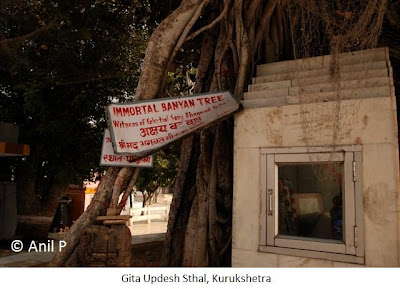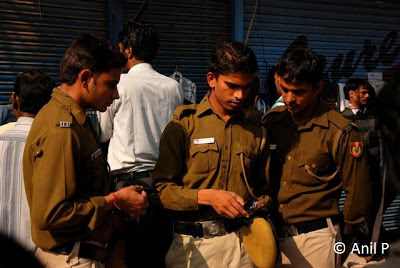I’m in Kurukshetra. It’s warm and
sunny. The visit took a long time coming. Someday, I used to tell myself every
once in a while over the years gone by, I’ll walk the hallowed grounds and imagine the setting that defined
the consciousness of a nation, and the centrality of life in a home my Mum shaped for us.
Accompanied by Sharmaji I walk
slowly toward the chariot behind Brahma Sarovar in Thanesar. I can see the charioteer in
the distance. I see Arjuna, his quiver of arrows. Krishna holds the reins as he turns his face toward Arjuna. Both are frozen in a moment that adorns countless
living rooms around the country, including our own from as long back as I can
remember. The four horses stand poised. The legacy of a civilisation stands poised.
This was the place, I tell myself
as I turn around and take in the serenity, and the silence. It’s around here it
happened. It’s from here I derive a part of my identity. And it’s here Geeta Saar still echoes with its import and insight, radiating outward from the very
earth that blood once covered.
Stepping up to a board Haryana
Tourism has put up, I trail my eyes along the familiar, letting the words sink
in, stirred by their import, their significance, and the insight of the
charioteer, Krishna .
क्यों व्यर्थ
चिंता करते
हो?
किससे व्यर्थ डरते हो?
कौन तुम्हें मार सक्ता है?
किससे व्यर्थ डरते हो?
कौन तुम्हें मार सक्ता है?
अात्मा ना
पैदा होती
है, न
मरती है।
Why do you worry
without cause?
Whom do you fear
without reason?
Who can kill you?
The soul is neither
born, nor does it die.
~
जो हुअा, वह अच्छा हुअा,
जो हो रहा है, वह अच्छा हो रहा है,
जो होगा, वह भी अच्छा ही होगा।
तुम भूत का पश्चाताप न करो।
भविष्य की चिन्ता न करो। वर्तमान चल रहा है।
Whatever happened,
happened for the good;
whatever is
happening, is happening for the good;
whatever will happen,
will also happen for the good.
Do not have regrets
for the past.
Do not worry for the
future.
The present is
happening.
~
तुम्हारा क्या
गया, जो
तुम रोते
हो?
तुम क्या
लाए थे,
जो तुमने
खो दिया?
तुमने क्या
पैदा किया
था, जो
नाश हो
गया?
न तुम
कुछ लेकर
अाए, जो
लिया यहीं
से लिया।
जो दिया,
यहीं पर
दिया।
जो लिया,
इसी (भगवान)
से लिया।
जो दिया,
इसी को
दिया।
खाली हाथ
अाए अौर
खाली हाथ
चले।
जो अाज
तुम्हारा है,
कल अौर
किसी का
था, परसों
किसी अौर
का होगा।
तुम इसे
अपना समझ
कर मग्न
हो रहे
हो।
बस यही
प्रसन्नता तुम्हारे दु:खों का
कारण है।
What did you lose
that you cry about?
What did you bring
with you, which you think you have lost?
What did you produce,
which you think got destroyed?
You did not bring
anything, whatever you have, you received from here.
Whatever you have
given, you have given only here.
Whatever you took,
you took from God. Whatever you gave, you gave to him.
You came empty
handed, you will leave empty handed.
What is yours today,
belonged to someone else yesterday, and
will belong to someone else the day
after tomorrow.
You are mistakenly
enjoying the thought that this is yours.
It is this false
happiness that is the cause of your sorrows.
~
परिवर्तन संसार
का नियम
है।
जिसे तुम
मृत्यु समझते
हो, वही
तो जीवन
है।
एक क्षण
में तुम
करोड़ों के
स्वामी बन
जाते हो,
दूसरे ही
क्षण में
तुम दरिद्र
हो जाते
हो।
मेरा-तेरा,
छोटा-बड़ा,
अपना-पराया,
मन से
मिटा दो,
फिर सब
तुम्हारा है,
तुम सबके
हो।
Change is the law of
the universe.
What you think of as
death, is indeed life.
In one instance you
can be a millionaire, and in the next instance you can be steeped in poverty.
Yours and mine, big
and small - erase these ideas from your mind, then everything is yours and you
belong to everyone.
~
न यह शरीर तुम्हारा
है, न
तुम शरीर
के हो।
यह अग्नि,
जल, वायु,
पृथ्वी, अाकाश
से बना
है अौर
इसी में
मिल जायेगा।
परन्तु अात्मा
स्थिर है
- फिर तुम
क्या हो?
This body is not
yours, neither are you of the body. The body is made of fire, water, air, earth
and ether, and will disappear into these elements. But the soul is permanent -
so who are you?
~
Later, we drive on to where Gita
Updesh (Updesh = Teaching) was given by Lord Krishna to Arjuna in the middle of the battlefield, just before the Kurukshetra War
commenced.
Here, portions of the celestial
song rung again in the shade of the tree. Here. Here. Hear. Hear.
Note: Neither the shlokas
nor the translations are my constructs. Like his teachings, they are to be
found everywhere you turn, everywhere you do not seek.













































